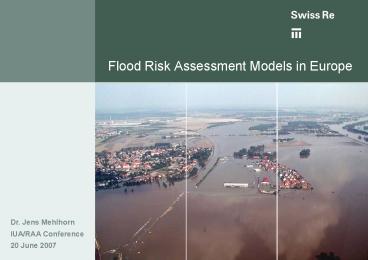Flood Risk Assessment Models in Europe - PowerPoint PPT Presentation
1 / 13
Title:
Flood Risk Assessment Models in Europe
Description:
HORA ( VV) (PIU) many different tools. mostly driven by Insurance Associations ... HORA ( VV) Guy Carpenter. SIGRA (ANIA) Benfield. Swiss Re /MMC. Guy Carpenter ... – PowerPoint PPT presentation
Number of Views:226
Avg rating:3.0/5.0
Title: Flood Risk Assessment Models in Europe
1
Flood Risk Assessment Models in Europe
Dr. Jens Mehlhorn IUA/RAA Conference 20 June 2007
2
Agenda
- Flood Losses in Europe
- Types of Flood Risk Assessment Models
- Model Availability
- Model Comparison
- Conclusions
3
Large Flood Events in Europe
Losses in million EUR inflated to 2006
Source Swiss Re Sigma
4
Flood and wind losses in Europe
Total Loss in million EUR inflated to 2006
Number of Events
Observation Period 1992 - 2006
Source Swiss Re Sigma
5
Flood Zones versus Flood Event
- Flood Zones
- zones for definedreturn periods along all rivers
in one country - -gt Flood zone lookup for single location UW
- Flood Event
- areas affected during one and the same event
- spatial correlation of high water
- -gt probabilistic models for Risk Management incl.
Reinsurance
Single Location
Portfolio
6
Flood Zone Model
7
Flood Zone Models in Europe
- many different tools
- mostly driven by Insurance Associations
- no consistent flood zone categories
- partly outdated
Environment Agency Several Proprietary Tools
(PIU)
ZUERS (GDV)
FRAT
HORA (ÖVV)
SIGRA (ANIA)
8
Probabilistic Fresh Water Flood Models in Europe
- many tools
- Consultants, Brokers, Reinsurers and Associations
- so far no cross-country /basin-wide
/Europe-wide model
- RMS
- Swiss Re (ZUERSII)
- EQE CAT
- Benfield
- Guy Carpenter
- RMS
- Swiss Re
- AIR (planed)
- Benfield
- Swiss Re /MMC
- Guy Carpenter
- RMS
- Swiss Re
- EQE CAT
- HORA (ÖVV)
- Guy Carpenter
- SIGRA (ANIA)
9
Model Comparison
- Modellers A, B and C
- Countries
- United Kingdom
- Germany
- Belgium
- (Austria)
- Normalized Market Portfolios
- Residential, Commercial and Industry
- Building, Contents and Business Interruption
- Comparison
- between countries
- between modellers in one country
- between single LoBs
10
Comparison between countries
- agreement between A, B and C about relative
exposure of markets GE gt BE gt UK - modeller C is always more conservative than
modeller A - modeller A is always more conservative than
modeller B
11
Germany Market Loss Curves
- all models are less than 2 years old
- shape of all curves are similar
- overall only small difference between A and B
- C more conservative
- small difference between all for low return
periods (lt 50 years) - event of 2002 had return period of about 50 years
12
Germany LoBs only for A and B
- shapes of all curves are similar
- A Res and Com almost identical, Ind more
exposed - B Res lt Com ltlt Ind
- A vs B market lower losses of B for Res and Com
are compensated by more conservative curve for
Ind
13
UK Market Loss Curves
- both models are one of the oldest probabilistic
fresh water models - overall A much more conservative than B
- however, high degree of consistency for return
periods lt30 years - Autumn 2000 event had return period of 20-30 years
14
Summary of model comparison
- probabilistic flood models are very complex and
sources of uncertainty are larger than for other
perils - However, there seems to be some consistency
between modellers which markets are more exposed
then others - recently released models in one market seem to
converge - closest match between models are achieved for low
return periods - however, different LoBs still deviate
substantially - local portfolios deviate also substantially (not
shown) - all modellers calibrate against the same market
losses
15
Conclusions
- Flood losses in Europe are comparable to
windstorm losses - more events but less severe
- low flood cover penetration might change in
future causing overproportional increase of
losses - Flood models are complex and expensive
- however, many flood risk assessment tools for
primary insurance and reinsurance UW are now
available - Probabilistic models show some degree of
consistency on a market level - however, larger differences remain for regional
portfolios and for different LoBs - Multi-Model use helps to reduce uncertainty































